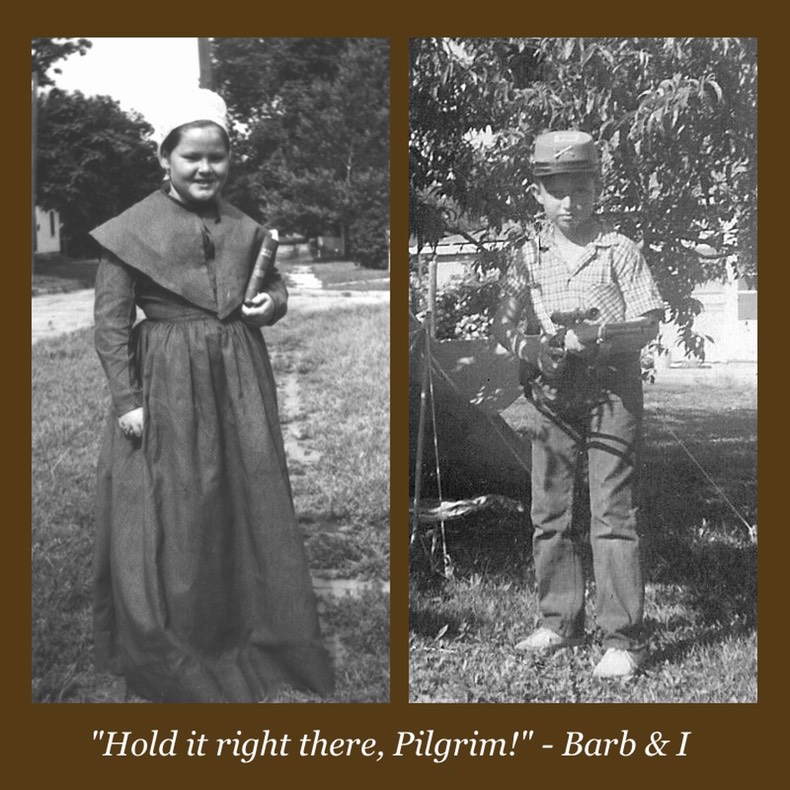This website grew out of conversations with Barb Gray, the great-great-granddaughter of Thomas Lovewell’s sister Hepsabeth. When we were exchanging notes in 2006 Barb and I both lamented the lack of information on the web pertaining to the Lovewell family. Spurred on after reading Roy V. Alleman’s “The Bloody Saga of White Rock” and Gloria Lovewell’s “The Lovewell Family,” Barb and her sister Bev Craig had made a tour of the old townsite of Lovewell and White Rock Cemetery in 2005. That was when Barb snapped the picture of the Lovewell Depot which introduces the slideshow on this site, and always will.
In those days it was nearly impossible to locate good photos of even such often-visited landmarks as the one memorializing Captain John Lovewell and his rangers at Lovewell Pond in Maine, or the handsome granite marker celebrating the life of Thomas Lovewell near the entrance to Lovewell State Park in Jewell County, Kansas. A shot I took of Thomas’s monument and posted on Flickr.com was my freshman effort at making Lovewell history more accessible.
Things have picked up over the last couple of years, thanks especially to Pontus Ross’s granddaughter A. J. Whitney, Thomas Lovewell’s great-grandson Dave Lovewell, Thomas’s great-great-grandson Phil Thornton, and Prof. J. T. Lovewell’s great-granddaughter Kathy Knight. All have contributed photographs, family stories and historical tidbits to the site. Lisa Lovewell, the wife of James Franklin Lovewell (great-great-grandson of William Lovewell), pointed me to sources on Thomas Lovewell’s brother William, and only a month or so ago alerted me to the portrait of Prof. Lovewell being offered on eBay.
A few years back, when I finally tracked down an available copy of the Rev. Lyman Lovewell’s 1854 “Sermon on American Slavery” it had to be printed on demand from a firm in Australia. The 1725 publication “Historical Memoirs of the Late Fight at Piggwacket” was also a print-on-demand item, but could at least be ordered from an American publisher. Today, we’re able to read both works online at Archive.org and other sources, along with many of Prof. Joseph Taplin Lovewell’s scientific writings, as well as his daughter Bertha’s translation of “The Life of St. Cecilia.” It’s a good time to be an online researcher.
Six months ago Dave Lovewell came across records showing that Thomas Lovewell, not content to be a humble abolitionist farmer in “Bleeding Kansas,” was bidding on mail routes in the young territory in 1858. Signing a one-year contract to tote a mail sack between Nottingham and Vermillion City, may have forced Thomas to delay his journey to Pikes Peak until late in 1859. Last month Dave made another discovery that fell closer to home and required no googling. After buying a piece of land at the north end of Switzer’s Gap in Jewell County, he learned that it had once been owned by his great-grandfather, who was sued posthumously, in fact, 13 years after his death, along with several other interested parties, probably over a second mortgage. We’ll have more on that another time.
Fittingly enough, much of the armchair detective work (what my friend Barb likes to call “nightgown research”) represented here is made possible by a Lovewell relative. Sir Tim Berners-Lee, who created the protocols for the World Wide Web, like most of the family members listed above, is a descendant of Captain John Lovewell through the famous Indian-fighter’s son Nehemiah. Thanks, Sir Tim.

It transpires that Barb and I have more in common than a penchant for dressing up in historical gear when we were children. Barb grew up in Beatrice, Nebraska, a stopping-off point for my Switzer antecedants, who lived there for several years before migrating to the Lovewell area, where my father was born. Barb’s husband Terry used to teach Shakespeare at Palomar College north of San Diego. Years before I bumped into Barb on an Ancestry chat site, I frequented Terry’s annotated guide “Mr. Shakespeare and the Internet,” which unfortunately finally shuttered its portals after Terry’s retirement in 2014.
Barb also happens to be an old chum of John Morgan, a film composer and orchestrator who teamed with conductor William Stromberg to produce a stunning series of re-creations of classic film scores released on the Marco Polo label, and later their own Tribute Film Classics. Not only had I long been an admirer of their work in particular, but of orchestral film music in general, smitten at the age of two* when my parents took me to see “Beneath the 12-Mile Reef” at Scandia, Kansas, and Bernard Herrmann seeped into my bloodstream.
When I was working at a radio station in Manhattan, Kansas, in 1974, music director Ed Klimek asked me if I wanted anything for myself as he was filling out an order form for a big box of albums for the FM station. Aerosmith, Doobie Brothers, Joni Mitchell, perhaps? No, I wanted Miklos Rozsa’s recording of his score for “The Golden Voyage of Sinbad.” I got a funny look from Ed, but he ordered the album. When the movie came out that summer, I took two girls to see it at separate showings, and wound up marrying the one who liked it better. There were many other reasons I married her, of course, but that one didn’t hurt. Ed was best man at our wedding. Thanks, Ed.
*I may have been three